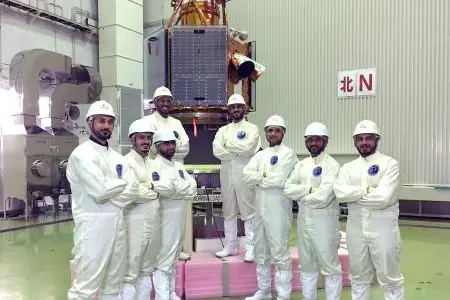PHOTO
Dubai, UAE: A team from Mohammed bin Rashid Space Centre (MBRSC) have conducted the final technical tests on KhalifaSat, which arrived at Tanegashima Space Center in Japan. KhalifaSat was prepared for mating with the Launch vehicle (Rocket H-IIA) and has been successfully installed into it and is awaiting launch on 29 October. The satellite is stored within a specially designed area called the Vehicle Assembly Building (VAB) until the launch date. KhalifaSat must be present in this area for 5 to 40 days before the launch date.
Technical tests were conducted on KhalifaSat to determine its safety on the rocket H-IIA. These tests include a functional verification test to confirm that all the sub-systems are working well, battery safety testing, and other related tests. Mitsubishi Heavy Industries providing the team with all the necessary facilities to carry out these tests.
His Excellency Yousuf Hamad Al Shaibani, Director General of MBRSC, said, “Conducting the technical tests on KhalifaSat the first satellite developed 100% in the UAE is an important step in preparation for its launch from Tanegashima Space Center in Japan. The Center was selected as it is as the largest rocket launch complex in Japan and one of the rare sites in the world that allows satellites and other spacecrafts into orbit, due to its facilities which help to achieve a series of operations such as assembling spacecrafts, maintenance, final testing of satellites, installing spacecrafts, follow-up after installation, and tracking of spacecrafts after take-off.”
Al Shaibani stressed that MBRSC is committed to implementing the directives of the UAE’s wise leadership, achieving its objectives towards space exploration and investment, and increasing efforts to develop this sector by promoting innovation and enhancing the skills of Emirati youth. He added that these dedicated Emirati youth are the reason for the completion of KhalifaSat, which will launch soon to begin its five-year planned mission life to provide information aimed at improving the quality of life."
Eng. Amer Al Sayegh, KhalifaSat Project Manager, at MBRSC, highlighted that “conducting the technical tests on KhalifaSat at Tanegashima Space Center on schedule reflects the success of MBRSC’s plan to launch it on 29 October. It also shows the high level of professionalism of the 70 male and female Emirati engineers working on this huge project”.
MBRSC had previously announced that 29 October, 2018 is the official date for the launch of KhalifaSat, into orbit aboard H-IIA rocket at the Tanegashima Space Centre in Japan for a planned mission life of five years. For this, MBRSC is partnering with Mitsubishi Heavy Industries (MHI) and the Japan Aerospace Exploration Agency (JAXA).
Once deployed into a Low Earth Orbit (about 613 km up), it will capture and deliver high-quality detailed images of Earth to the ground station at MBRSC, Dubai. This service will assist government organisations and private sector enterprises all over the world. KhalifaSat weighs in at just 330 kg. It contains an advanced positioning system that allows a large number of 3D images to be captured at once, with excellent accuracy and speed. The images will be used to detect the effects of global warming, ensure responsible urban planning and management, and aid relief efforts for natural disasters. KhalifaSat has a planned mission life of five years.
-Ends-
About MBRSC:
The Mohammed Bin Rashid Space Centre, founded in 2006, is home to the UAE National Space Programme. The Centre builds and operates earth observation satellites, offering imaging and data analysis services to clients around the world. The Centre launched DubaiSat-1, DubaiSat-2, and work is underway to launch KhalifaSat, which is being built purely by Emirati engineers in the UAE. The Centre is responsible for the development of the Emirates Mars Mission and the Mars Hope Probe, a mission to reach Mars orbit by 2021 and gather key science data about Mars’ atmosphere, as well as the UAE Astronaut Programme and the development of the Mars 2117 vision to build a human colony on Mars. The first step in that vision, the Mars Scientific City, will launch in 2020.
For media inquiries:
Mahra Mohammad Al Falasi
Corporate Communications Department
+97146071200-ext 380
© Press Release 2018Disclaimer: The contents of this press release was provided from an external third party provider. This website is not responsible for, and does not control, such external content. This content is provided on an “as is” and “as available” basis and has not been edited in any way. Neither this website nor our affiliates guarantee the accuracy of or endorse the views or opinions expressed in this press release.
The press release is provided for informational purposes only. The content does not provide tax, legal or investment advice or opinion regarding the suitability, value or profitability of any particular security, portfolio or investment strategy. Neither this website nor our affiliates shall be liable for any errors or inaccuracies in the content, or for any actions taken by you in reliance thereon. You expressly agree that your use of the information within this article is at your sole risk.
To the fullest extent permitted by applicable law, this website, its parent company, its subsidiaries, its affiliates and the respective shareholders, directors, officers, employees, agents, advertisers, content providers and licensors will not be liable (jointly or severally) to you for any direct, indirect, consequential, special, incidental, punitive or exemplary damages, including without limitation, lost profits, lost savings and lost revenues, whether in negligence, tort, contract or any other theory of liability, even if the parties have been advised of the possibility or could have foreseen any such damages.











